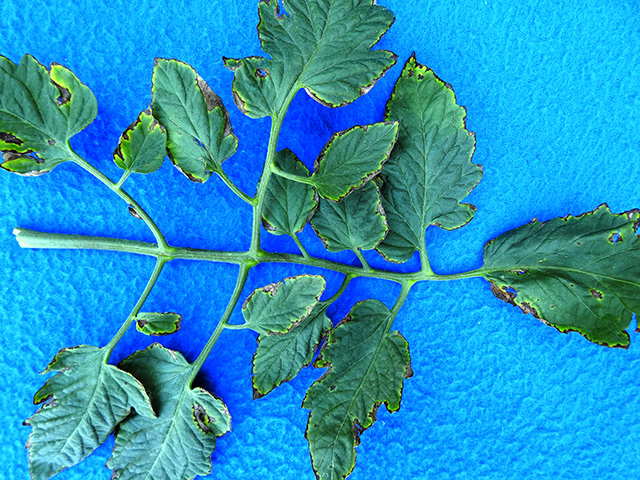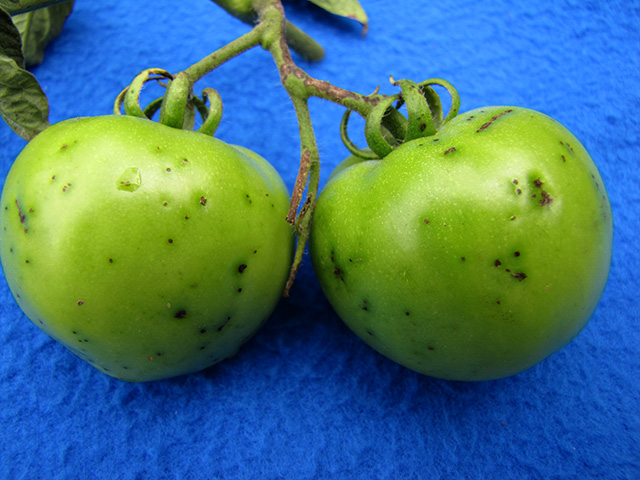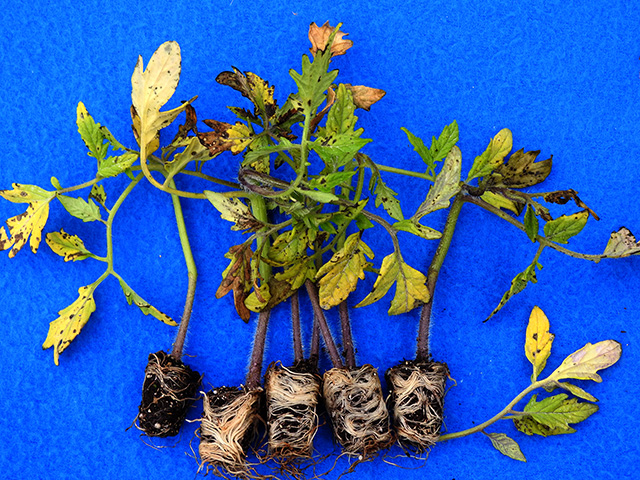Bacterial speck is the most common disease of tomato caused by a bacterial pathogen on Long Island. Symptoms develop on leaves, fruit spurs, stems and petioles, and occasionally fruit.
Often symptoms first appear and are most common on more susceptible younger leaves, but they can appear first on older leaves. Leaf spots appear water-soaked when they are starting to develop and during rainy periods. They are dark brown to black, sometimes with a yellow halo, and typically small (up to 1/4 inch wide). But on young, developing leaves spots are often larger, irregular in shape, and cause leaves to be distorted and sometimes torn. Also as the disease progresses, spots coalesce forming large, irregular brown areas. Margins of leaves can be brown, sometimes extending down into the leaf forming a wedge of brown tissue. Severely affected leaves often turn yellow and then die.
Spots on stems and petioles are small and often oval-shaped extending along the length of the stem. They can coalesce creating large areas of brown tissue
Fruit spots are tiny (usually less than 1/16 in), dark brown, and superficial (usually removable by scraping with a finger nail). They may be indented. Only green fruit are susceptible to infection.
Occasionally symptoms have been seen on transplants growing in a greenhouse. This can occur when contaminated seed is planted or there was not adequate sanitation of the greenhouse and planting materials being reused following a previous outbreak.
Pathogen can be present on tomato leaves in low numbers, not causing disease until favorable conditions enable them to multiply.
Wet, cool (55-77°F) conditions are favorable for bacterial speck. Rainy weather provides splashing water to disperse the bacteria and leaf wetness needed for infection.
Initial sources of the pathogen include infested seed, infected transplants, wind-driven rain from affected plants in another planting nearby, and contaminated tools or hands from exposure at another planting. After bacterial speck has occurred in a field, the bacteria can survive in plant debris and seeds in the soil, on stakes used to support plants, and in weeds (especially those in the nightshade family). Bacteria can also survive on greenhouse structures and planting materials after developing on seedling. These are all potential sources of the pathogen for subsequent crops. This pathogen can become established in an area, surviving on the surface of non-host plants.
Manage bacterial speck by selecting resistant varieties. There are few currently available. See resistant variety tables. Clean and disinfect before planting including greenhouse benches and trays plus other planting materials that are being re-used. Use seed that was tested and/or treated for bacteria causing speck. When using your own seed or seed from a non-commercial source, before planting treat it with hot water following guidelines carefully to increase success and not damage seed.
Inspect transplants carefully at time of purchase: select plants with no leaf spots, but note that plants without symptoms could be infected. Rotate where tomatoes are grown so there is at least 2 years between plantings. Destroy any volunteer tomato plants. Manage weeds in the nightshade family. Use drip rather than overhead irrigation. Mulching under plants with straw or plastic minimizes the potential for any bacteria on debris to be splashed from the soil up onto the plants. Trellising will improve air movement around the plants, thereby promoting drying and reducing the time plant tissue is wet and able to be infected.
Actigard is the most effective fungicide to use in commercial plantings, but applications need to start before infection to obtain the most benefit as this is a plant activator. It can be applied starting within one week of transplanting for up to 8 weekly sequential applications until 2 weeks before start of harvest. LifeGard is a new biological activator approved for organic production that can be applied from before transplanting through harvest (0 day PHI). Other fungicides are also best used on a preventive schedule. BacStop, Double Nickel, OxiDate, Regalia, and Serenade are approved for use on organically-produced crops. There are several copper fungicides, including organic formulations. They differ in amount of metallic and biologically active copper. The conventional fungicide ManKocide also has mancozeb, which can increase copper activity. Do not use an air-blast sprayer when a bacterial disease is present as these pathogens can be easily moved in the spray as it is driven through the plant canopy to adjacent rows.
Please Note: Fungicides mentioned are for use in commercial production, not gardens. The specific directions on pesticide labels must be adhered to — they supersede these recommendations if there is a conflict. Any reference to commercial products, trade or brand names, is for information only; no endorsement is intended. For up-to-date information on labeled conventional fungicides see Cornell Integrated Crop and Pest Management Guidelines for Commercial Vegetable Production and biopesticides see the Biopesticides website.














